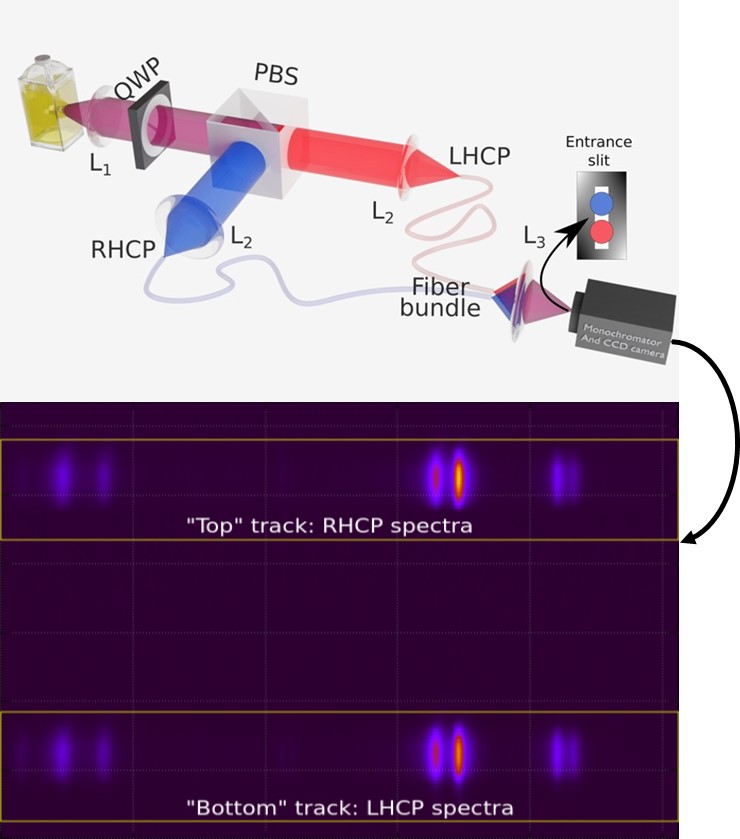
Mesures rapides et sans artefacts de la CPL
Fast and artifact-free measurements of CPL
Bruno Baguenard, Amina Bensalah-Ledoux, et Stéphan Guy, (équipe MNP), en collaboration avec des collègues de Lyon ont publié un article intitulé "Theoretical and experimental analysis of circularly polarized luminescence spectrophotometers for artifact-free measurements using a single CCD camera" dans la revue Nature Communications.
Bruno Baguenard, Amina Bensalah-Ledoux, and Stéphan Guy, (MNP team), in collaboration with colleagues from Lyon have published a paper entitled "Theoretical and experimental analysis of circularly polarized luminescence spectrophotometers for artifact-free measurements using a single CCD camera" in Nature Communications.
Ce travail démontre la faisabilité d’un spectromètre de CPL (Circularly Polarized Luminescence) avec une réduction du temps d’acquisition d’un facteur 1000 par rapport aux appareils actuels et ceci sans les artefacts inhérents à ce genre de spectroscopie. C’est l’utilisation d’une caméra spectrale couplée à une séparation spatiale des polarisations qui permet d’enregistrer des spectres « one shot ». Ceci est une avancée majeure par rapport aux appareils usuels qui utilise une modulation temporelle de la polarisation et, de ce fait, requièrent des enregistrements longueur d’onde par longueur d’onde. La fiabilité des mesures est assurée par une méthode d’auto-compensation des artefacts provenant des imperfections résiduelles des composants optiques. Cet aspect est fondamental dans le cadre des études chiroptiques car les signaux – de quelques 0,01 % à quelques % – peuvent facilement être masqués ou même confondus avec des biais instrumentaux. Grace à notre dispositif, des études sur le couplage entre la chiralité et la génération d’aimants moléculaires, l’induction de chiralité de ligands organiques vers des terres rares ou encore le développement de sondes biologiques chirales ont déjà été menées. Plus généralement, ces développements permettent d’envisager des études fondamentales sur les interactions chirales via la luminescence, études jusqu’à présent limitées par des temps d’acquisitions rédhibitoires.
This work demonstrates the feasibility of a CPL (Circularly Polarized Luminescence) spectrophotometer with a decrease in acquisition time of a factor of 1000 compared to current devices and without the artefacts inherent to this kind of spectroscopy. The use of a CCD spectral camera coupled to a spatial separation of polarizations allows "one shot" spectra recording. This is a major advance over conventional instruments that use time modulation of polarization and therefore require wavelength-by-wavelength scanning. Moreover, the reliability of the measurements is ensured by a method of self-compensation for artefacts arising from residual imperfections in the optical components. This aspect is fundamental in chiropractical studies because signals - from a few 0.01% to a few % - can easily be masked or even confused with instrumental biases. Thanks to our device, studies on the coupling between chirality and the generation of molecular magnets, the induction of chirality of organic ligands to rare earths or the development of chiral biological probes have already been carried out. More generally, these developments enable fundamental studies on chiral interactions via luminescence, studies that have so far been limited by prohibitive acquisition times.

Schematic of CPL spectrophotometer based on polarization spatial separation by mean of quarter wave plate (QWP) and polarizing beam splitter (PBS) association, before dispersion on a CCD detecto

















